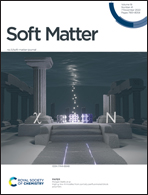Equilibrium morphology of tactoids in elastically anisotropic nematics
Abstract
We study two dimensional tactoids in nematic liquid crystals by using a Q-tensor representation. A bulk free energy of the Maier–Saupe form with eigenvalue constraints on Q, plus elastic terms up to cubic order in Q are used to understand the effects of anisotropic anchoring and Frank–Oseen elasticity on the morphology of nematic–isotropic domains. Further, a volume constraint is introduced to stabilize tactoids of any size at coexistence. We find that anisotropic anchoring results in differences in interface thickness depending on the relative orientation of the director at the interface, and that interfaces become biaxial for tangential alignment when anisotropy is introduced. For negative tactoids, surface defects induced by boundary topology become sharper with increasing elastic anisotropy. On the other hand, by parametrically studying their energy landscape, we find that surface defects do not represent the minimum energy configuration in positive tactoids. Instead, the interplay between Frank–Oseen elasticity in the bulk, and anisotropic anchoring yields semi-bipolar director configurations with non-circular interface morphology. Finally, we find that for growing tactoids the evolution of the director configuration is highly sensitive to the anisotropic term included in the free energy, and that minimum energy configurations may not be representative of kinetically obtained tactoids at long times.



 Please wait while we load your content...
Please wait while we load your content...